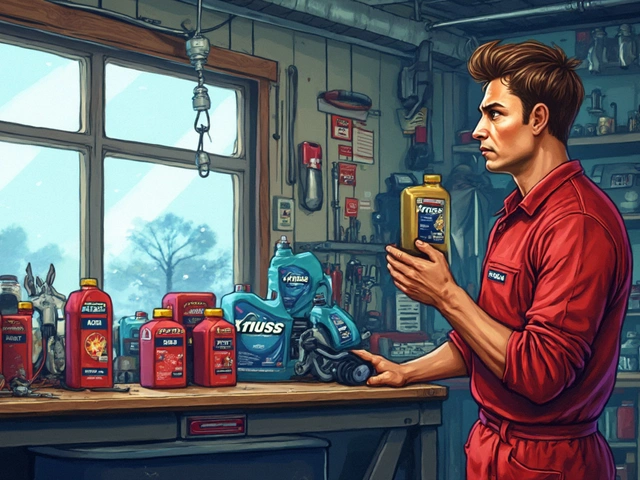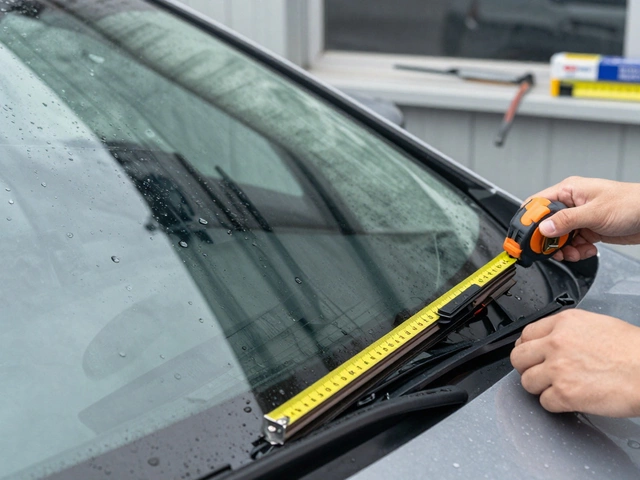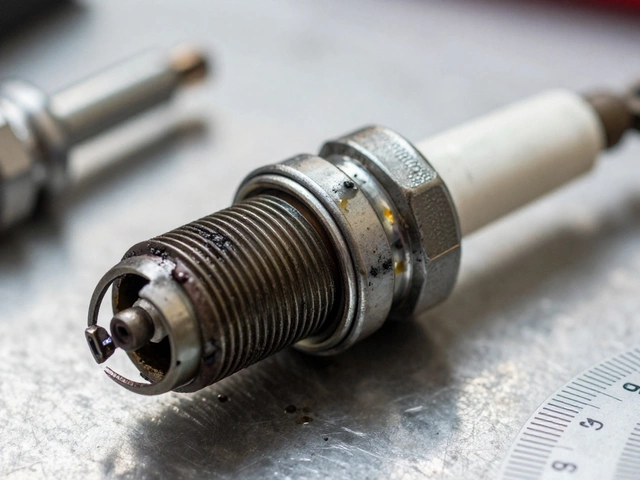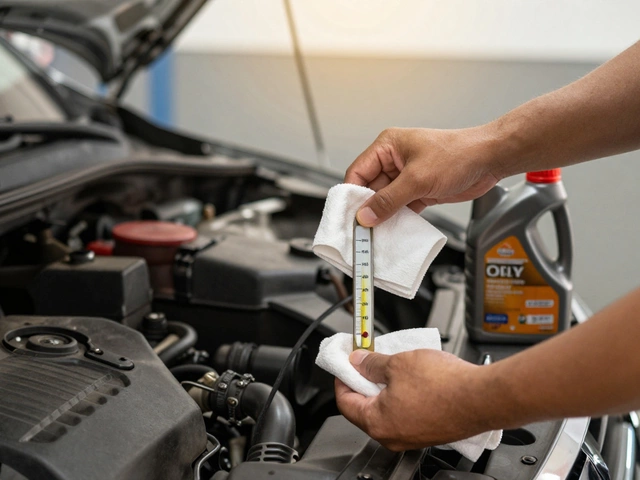Oil Level Temperature Adjuster
How Temperature Affects Oil Level
Oil expands by approximately 0.015mm per 10°F temperature change. For accurate readings, you should check oil when the engine is cold (at room temperature). This tool adjusts your dipstick reading to what it would be at standard temperature.
Enter values to see adjusted oil level
Engine oil level is vital for your car's health, yet many owners aren’t sure what the gauge should show. Getting the right reading can prevent costly engine damage and keep performance smooth.
Below you’ll find a step‑by‑step guide that covers everything from locating the gauge to interpreting temperature‑adjusted readings, plus a quick checklist you can print out.
Why the Right Oil Level Matters
Having too little oil means the moving parts inside the crankcase can rub together, leading to wear, overheating, and even a seized engine. Too much oil, on the other hand, creates excessive foaming, reduces lubrication, and can cause oil to leak into the combustion chamber.
According to a 2023 survey by the Automobile Association (AA), 42% of breakdowns in the UK are linked to improper oil levels, making regular checks a simple way to avoid a big headache.
Locating Your Oil Gauge or Dipstick
Most cars use a manual oil dipstick is a slender metal rod that slides into a sealed tube, letting you see the oil line. In newer models, a digital oil gauge on the instrument cluster displays the level with a bar or a numeric value.
Before you check, park on a level surface, turn off the engine, and wait at least five minutes so the oil can settle back into the sump.
How to Read a Manual Dipstick
- Pull the dipstick out and wipe it clean with a lint‑free cloth.
- Re‑insert it fully, then pull it out again.
- Look for two marks on the stick - usually labeled “MIN” and “MAX”, or “LOW” and "FULL".
- If the oil film sits between the marks, the level is correct.
- Below the lower mark means you need to add oil.
- Above the upper mark indicates too much oil.
Take note of the oil's color and viscosity. Fresh oil is amber and translucent; dark, gritty oil suggests it’s time for a change.
Understanding Digital Oil Gauge Readings
Digital gauges often use a bar that moves from red (low) to green (optimal) to blue (high). Some systems, like those in the 2024 Ford Maverick, show the exact liters remaining.
When you glance at the display, make sure the car is cold or has been off for a few minutes - hot oil expands, so a reading taken immediately after driving can appear higher than the actual level.
How Temperature Affects the Reading
Oil expands about 0.00022 ft³ per °F (≈0.015% per 10 °F). In practical terms, a 20 °F change can shift the dipstick reading by roughly 0.3 mm - enough to cross the MIN/MAX line on some tightly‑toleranced engines.
For colder climates (like Manchester winters), let the engine idle for a minute after turning it off; this lets the oil warm just enough to give a reliable reading without excessive expansion.
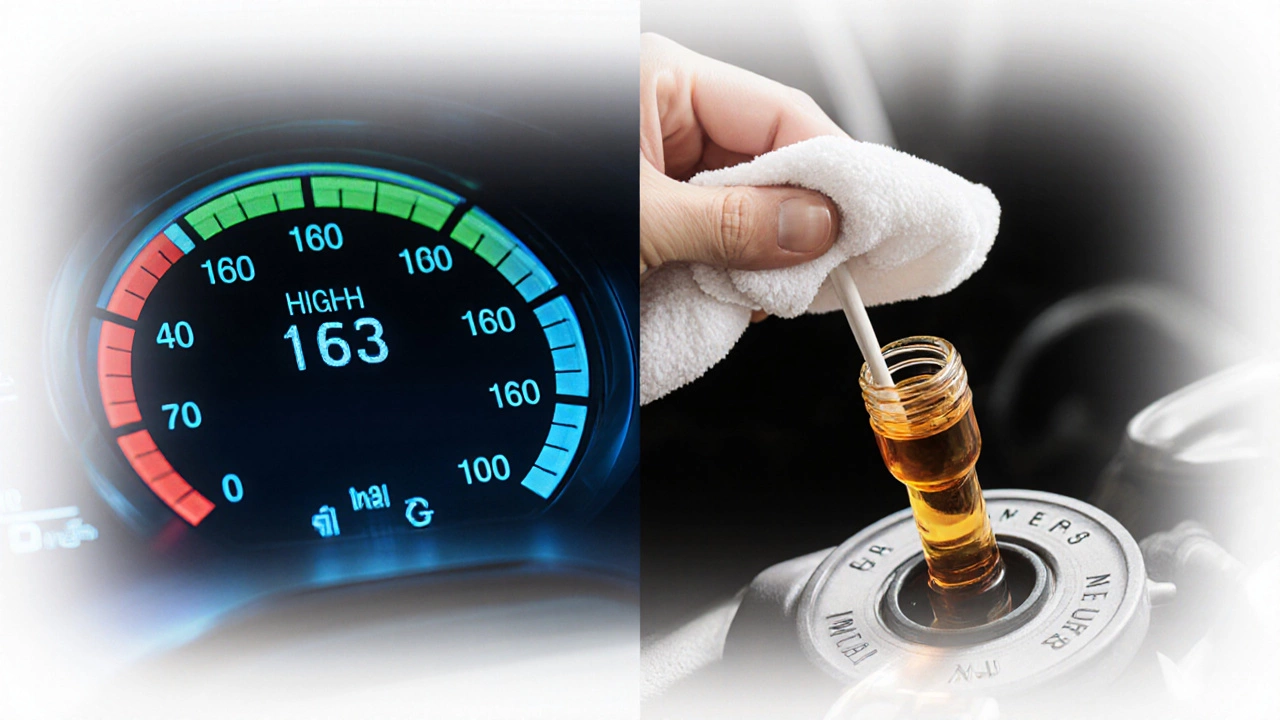
Key Oil Specifications to Check
Before topping up, confirm the required oil viscosity grade is correct for your engine. The owner’s manual-often referred to as the owner’s manual-lists the recommended SAE rating (e.g., 5W‑30).
Using the wrong viscosity can cause the gauge to read inaccurately because the oil’s density changes.
What to Do If the Level Is Too Low
1. Locate the appropriate oil type (matching the SAE rating and API service classification). 2. Use a clean funnel to add oil a little at a time, rechecking the dipstick after each pour. 3. If the level climbs quickly or you notice foam, stop adding - you may have a leak or over‑filling issue.
Persistent low readings often point to a leak, a blown gasket, or worn piston rings. In those cases, have a mechanic inspect the crankcase.
What to Do If the Level Is Too High
Excess oil can be drained using a pump or by loosening the drain plug for a few seconds. After removing the surplus, re‑check the level.
If the oil keeps rising after you’ve removed the excess, it could be due to coolant mixing (a sign of a blown head gasket) or fuel dilution from frequent short trips.
Regular Maintenance Schedule
Most manufacturers recommend checking the oil level at every fuel fill‑up. Additionally, follow the oil change interval-typically every 5,000 - 10,000 km for synthetic oils, or 3,000 km for conventional oils.
Replacing the oil filter at each change ensures contaminants don’t clog the system, helping the gauge stay accurate.
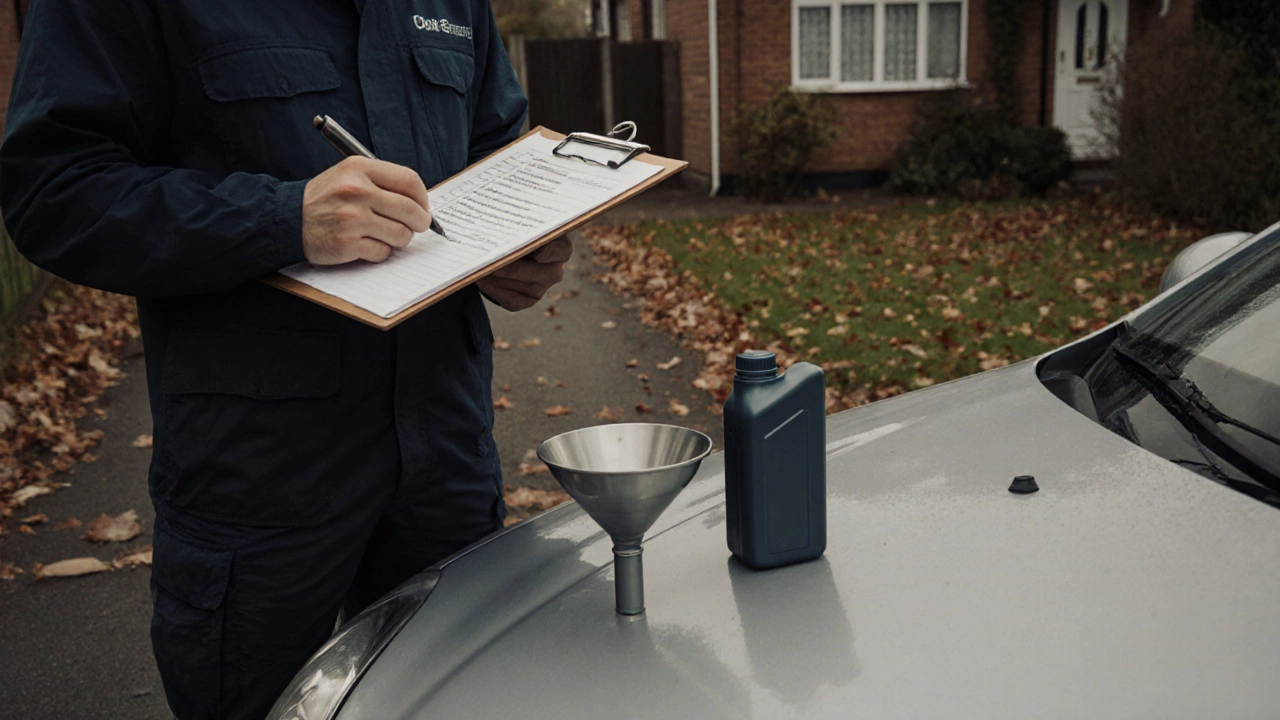
Quick Reference Checklist
- Park on level ground, engine off for 5 min.
- Pull dipstick, wipe, re‑insert, pull again.
- Confirm oil sits between MIN and MAX marks.
- Check oil color and smell for signs of degradation.
- Verify oil viscosity matches the owner’s manual recommendation.
- Add or remove oil in small increments if needed.
- Record date, mileage, and type of oil added.
Common Mistakes to Avoid
Checking oil when hot: The oil expands, giving a false high reading.
Using the wrong dipstick: Some models have separate sticks for engine and transmission oil.
Ignoring the "full" line: Over‑filling can cause foaming and loss of lubrication.
| Vehicle Type | Mark Description | Recommended Check Frequency |
|---|---|---|
| Compact cars (e.g., Ford Fiesta) | "Low" and "Full" etched on dipstick | Every fuel fill‑up |
| Medium SUVs (e.g., Toyota RAV4) | "MIN" and "MAX" stamped | Every 1,000 km |
| Heavy‑duty trucks (e.g., Volvo FH) | Two circles with "L" and "H" | Every 2,000 km or weekly |
Troubleshooting FAQs
Frequently Asked Questions
Why does my oil gauge show full even after I added oil?
If the engine is hot, the oil expands, making the gauge read higher. Let the engine cool for a few minutes and re‑check. Also verify you used the correct viscosity; mismatched oil can give a false high reading.
Can I rely on the digital oil gauge alone?
Digital gauges are handy, but they can drift over time. It’s wise to do a manual dipstick check at least once a month to confirm accuracy.
What should I do if the oil looks milky?
Milky oil usually means coolant is mixing with oil - a sign of a blown head gasket. Stop driving and have the engine inspected immediately.
Is it okay to add oil through the dipstick tube?
Yes, most cars let you pour oil directly into the dipstick tube. Use a clean funnel to avoid spilling, and add in small amounts, checking the level each time.
How often should I replace the oil filter?
Replace the oil filter with every oil change. For synthetic oil, that’s typically every 8,000-10,000 km; for conventional oil, aim for every 5,000 km.

